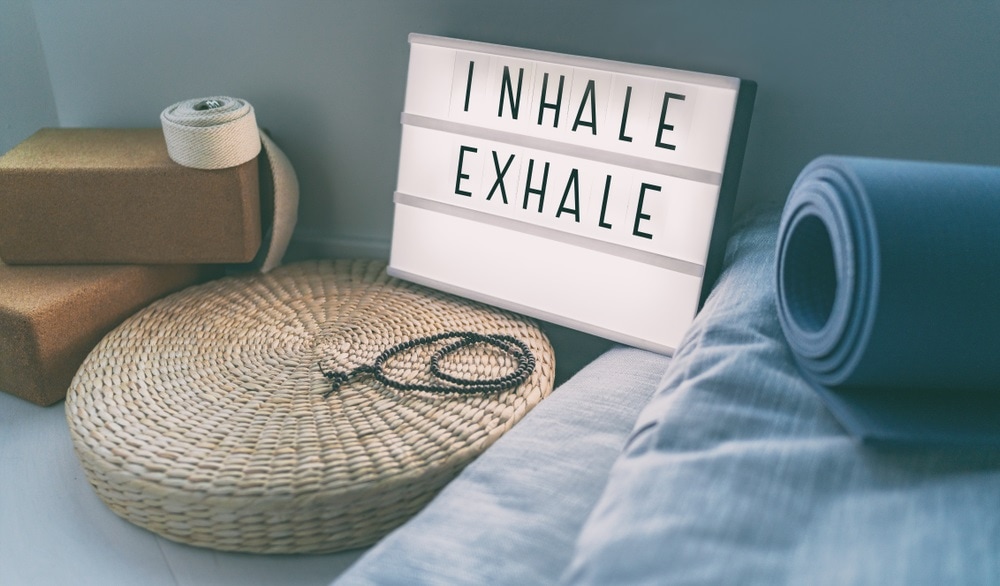If you’ve ever been told to “just breathe,” you may have wondered if there was any benefit to it or if perhaps you were just wasting time breathing until you felt better. Scientists have weighed in on the issue and have recently discovered that how we breathe strongly affects our physical and mental health.
We are more in charge of our own health than we once thought. The power of breathing patterns is one easy way to help you conquer bouts of stress and anxiety.
Let’s explore the fine art of “breathing” and learn why this practice is something we should learn to master during times of stress or discomfort.
What Are Breathing Patterns?
We rarely think about our breathing – and that’s mostly a good thing! Imagine having to think about taking a breath on a 24/7 basis. Fortunately, breathing centers in the brain regulate your ability to breathe even when you don’t think about it.
The problem comes when you become stressed or anxious. Modern stress is often just as threatening to your nervous system as you’d have felt about a charging rhinoceros 50,000 years ago.
In modern times, however, you rarely need to sprint out of the way of whatever bothers you. Even so, your heart rate goes up, and you breathe rapidly – as if you are running a marathon – even if you’re just sitting in an office chair.
With that kind of rapid breathing pattern, it’s no wonder you feel so stressed out!
Your breathing patterns say a lot about how you’re feeling. You can easily say a person is nervous after watching them sigh heavily as they breathe through their mouth at a rapid pace. A sleeping baby has a very different pattern of breathing. What do these different breathing patterns mean for our health?
Definition of Breathing Patterns
Doctors have specific ways of talking about breathing patterns. The breath rate is the number of breaths you take per minute. A normal resting breathing rate in an adult is 10-12 breaths per minute.
Doctors also note the depth and regularity of breathing. When you breathe deeply, the lungs fill up, and you improve the exchange of oxygen and carbon dioxide in the lung tissue. Shallow breaths are much less effective in getting oxygen into the body.
Those are the basics – breath rate, depth, and regularity. Those who study breathing, however, say that there is more to a breathing pattern than those parameters:
Your Breathing “Style”
This refers to breathing mainly with your diaphragm or the chest. When you engage in chest breathing, your shoulders rise and fall with each breath, and the deeper lung tissues don’t get enough inspired air. You need to breathe more rapidly with this style, and you will likely feel more anxious breathing this way.
Breathing deeply and using your diaphragm is called diaphragmatic breathing. Air is drawn more deeply into your lungs, filling all of the lung chambers with needed oxygen. You can also breathe more slowly, which teaches your brain to think “calming thoughts.” This breathing style is also called belly breathing because your abdomen rises and falls with each breath.
Other Breathing Parameters
Doctors rarely mention if their patient is breathing through the mouth or nose; however, this is a good parameter to track in your own breathing. Mouth breathing is linked to higher anxiety than nostril or nose breathing. Breathing through your nose offers you a greater opportunity to take in a slow breath. There are other benefits to nose breathing that we’ll talk about soon.
Benefits of Practicing Breathing Patterns
The way you breathe is closely connected to how you feel, but how? Researchers say that the communication from your body (breathing) to the brainstem (where the respiratory centers lie) is just as strong as the communication from the brain to the body.
When you breathe slowly and deeply, you send calming messages to your brain. This sends another signal to your heart and blood vessels, lowering your pulse and blood pressure. This benefits your whole body, potentially reducing your long-term heart disease and stroke risk.
Finally, breathing through your nose seems to have benefits that scientists have only recently discovered. An inward breath through your nostrils carries a tiny gas called nitric oxide from the nasal passages to the lungs. Once absorbed into the bloodstream, nitric oxide opens the blood vessels, further reducing blood pressure and improving blood supply to all parts of the body.

How to Practice Breathing Patterns
It isn’t hard to practice the various breathing patterns. Find one that helps you feel more grounded, happier, or calmer. Use it to tell your brain you’re okay when it’s stressing you out.
Let’s look at the most common breathing patterns to see how they are done.
Diaphragmatic Breathing
This involves using the big muscle between the chest and abdomen. Slowly draw in a breath from the deepest part of your chest. You will know you are deep breathing correctly when your belly rises and falls with each breath and your shoulders are not moving much.
Slow breathing is best. Try slowing your breath rate to about 6 breaths a minute. This is one breath every 10 seconds. It’s important to breathe slowly and fill your lung volume with each breath.
Alternate Nostril Breathing
This is a common technique used by yoga practitioners but has become popular for reducing anxiety and enhancing sleep. To do this method, you breathe through one nostril, holding the other closed with your thumb. After a single breath, release the nostril and close the other with your index finger. Take a single breath before repeating the pattern.
Try this for up to 15 minutes to reduce anxiety and enhance sleepiness. If you can’t do it for long, do it as long as you can and go up from there. See if you feel better after performing this breathing practice.
Square Breathing
Square breathing means you breathe in, hold your breath, and breathe out in a box-like pattern. Breathe in and count to 4 as you inhale. Hold your breath for 4 seconds and slowly exhale for another 4 seconds. Wait 4 seconds before beginning again. Because this periodic breathing process involves 4 equal breathing segments, it’s called “box breathing” or “square breathing.”
Athletes often use this breathing pattern to calm themselves and enhance focus before a big performance.
Humming Bee Breath
Having trouble with your breathing technique because of noise or distraction? Try humming bee breathing. This yoga technique involves closing your eyes, blocking your ears, and using diaphragmatic breathing, often at 6 breaths per minute. The difference is that you exhale using a humming sound (they say it sounds like a bee).
This is a great breathing technique when you are in a noisy environment. Many people say that the sound of humming is especially soothing as well.
FAQs
What are the benefits of practicing breathing patterns?
The benefits are enormous and include reduced anxiety, better sleep, lower blood pressure, and slower heart rate. Each of these benefits translates to improved health and longevity.
How often should I practice breathing patterns?
You can practice breathing whenever you feel stressed or before performing at work or in sports. Try slow, diaphragmatic breathing for 15 minutes before you retire to bed for better overall sleep.
Are there any risks associated with practicing breathing patterns?
There is no risk in practicing breathing patterns if you are healthy. Those with advanced kidney disease or known acidic blood conditions should talk to their doctor before doing any breathing practice. This is because breathing helps regulate blood acidity along with your kidneys.
References:
- Bhramari Breathing. https://homebase.org/bhramari-breathing/#:~:text=Keeping%20your%20ears%20blocked%2C%20take,as%20long%20as%20you%20like.
- Kamath, A., Urval, R. P., & Shenoy, A. K. (2017). Effect of Alternate Nostril Breathing Exercise on Experimentally Induced Anxiety in Healthy Volunteers Using the Simulated Public Speaking Model: A Randomized Controlled Pilot Study. BioMed research international, 2017, 2450670. https://doi.org/10.1155/2017/2450670.
- Maniscalco, M., Weitzberg, E. Sundberg, J., Sofia, M., Lundberg. J. Assessment of nasal and sinus nitric oxide output using single-breath humming exhalations. European Respiratory Journal 2003 22: 323-329; https://doi.org/10.1183/09031936.03.00017903.
- Marc A. Russo, Danielle M. Santarelli, and Dean O’Rourke. The physiological effects of slow breathing in the healthy human. Breathe Dec 2017, 13 (4) 298-309; https://doi.org/10.1183/20734735.009817.
- What is Box Breathing? https://www.medicalnewstoday.com/articles/321805.

